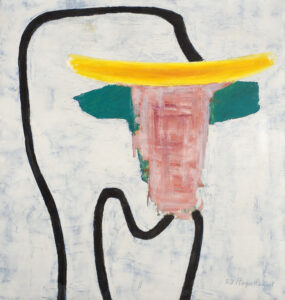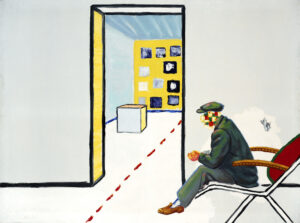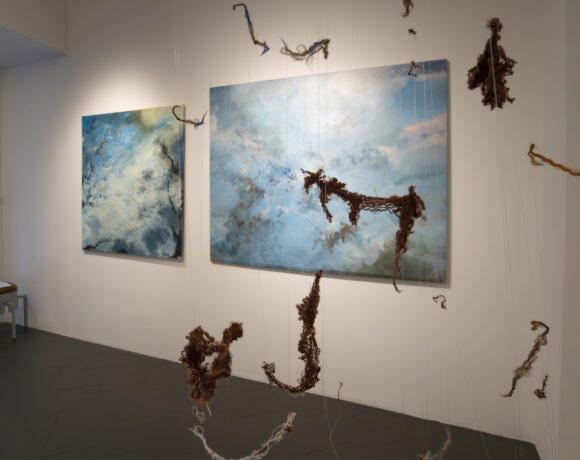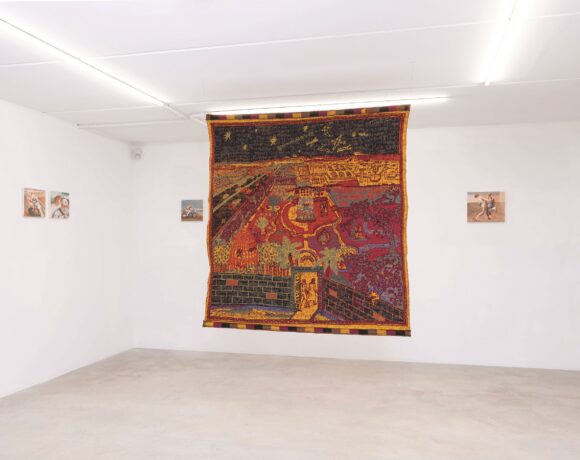To celebrate the centenary of Roger Raveel (1921-2013) – one of the most important Belgian artists of the second half of the 20th century – the Bozar art center in Brussels has inaugurated a retrospective with his most interesting works. Characterized by a language in balance between abstraction and figuration that distinguishes him from other artists of his time, Raveel spent his entire life in his native village, Machelen-aan-de-Leie, attracted by the universal signs of everyday life.
1948 – the year from which Bozar’s exhibition kicks off – also marks the starting point of Raveel’s research and “the birth of his oeuvre” as he himself affirms. Influenced by Flemish expressionism, he realizes that realism is not synonymous with naturalism and decides to develop his own style. During his career, he has often portrayed himself, highlighting not only his physical changes but also his artistic evolution. After many attempts, the artist paints the Self-portrait with cigarette (1952) in which the representation gets approximative. It becomes extremely difficult to recognize a visage due to the lack of identity: eyes, eyebrows, nose, lips, and ears are barely noticeable. Raveel conceives this painting as a statement, which affirms that art is not related to the exact reproduction of the visible reality.
Influenced by abstract art and Piet Mondrian, Raveel often portrayed his wife and father who, due to the lack of facial features or covered with geometrical figures, are barely recognizable. Other subjects that the painter immensely loves are the interiors of his house and the adjacent garden. It is in the latter that his “stripe figures” appear for the first time, subjects characterized by parallel lines, often colored in yellow, which allow Raveel to give volume to his figures without painting them realistically.
Despite his country life, Raveel knows his time very well and represents the changes he observes day after day. In From My Garden (1949), he paints a garden at the back of a house in which he does not focus on the plant elements but on the poles, fences and windowless houses that appear on it. The artist uses concrete to depict the intrusion of modernity into country life and his village.
Feeling more and more alienated and distant from what happens around him, between 1956 to 1962, the artist begins to immerse himself in the natural world and his subjects move away from realism. He places his tripod in the garden and lets himself go into total abstraction of the painting of forms. It is in this period that the shape of the square gradually appears in several paintings.
The turning point came in 1962 when, returning from an important Italian ceramic center, Raveel visited the 4 Amerikaner exhibition at the Bern Kunsthalle. He is particularly impressed with Robert Rauschenberg’s combine paintings. This discovery determines the end of his abstract period and his return to a new realism using real objects in his paintings. As a consequence of his research on the square shape and the use of object trouvé, the artist soon begins to insert mirror surfaces in his canvases, which become elements of conjunction and relation between his oeuvre and spectators. Sometimes, the objects come out of the painting and become autonomous subjects, as in Cart To Carry (1968), a wooden cube assembled on two bicycle wheels with a mirror on top. In this period, his research on the relation between reality and space of the canvas increases: the artist painted a series of works in which the border between art and life fades more and more. An example is Farmyard with Live Dove (1962-63), a huge panel with a live white dove in a cage at the center.
Since 1965, Raveel has experimented with graphics, in particular with the technique of lithography, etching, and xylography. During his career, he has collaborated with different writers and poets.
Almost still internationally unknown due to the lack of translation of his bibliography, Roger Raveel has been an artist sensitive to his time and the changes related to it. He was always looking for himself and for a new genuine and unexpected point of view on reality. The exhibition goes through his artistic path, bringing out what distinguished and characterized him, without taking anything for granted.
Martina Matteucci
Info:
Roger Raveel. A Retrospective
curated by Franz Wilhelm Kaiser
BOZAR – Centre for Fine Arts
Rue Ravenstein 23, 1000, Brussels
18/03/2021— 21/07/2021
 Roger Raveel, Bull, c. 1957, Private collection/Roger Raveel Museum © Raveel – MDM. Photo: Peter Claeys, courtesy BOZAR – Centre for Fine Arts, Bruxelles
Roger Raveel, Bull, c. 1957, Private collection/Roger Raveel Museum © Raveel – MDM. Photo: Peter Claeys, courtesy BOZAR – Centre for Fine Arts, Bruxelles
 Roger Raveel, Cart to Carry the Sky, 1968, Collection of the Flemish Community/Roger Raveel Museum © Raveel – MDM. Photo: Peter Claeys, courtesy BOZAR – Centre for Fine Arts, Bruxelles
Roger Raveel, Cart to Carry the Sky, 1968, Collection of the Flemish Community/Roger Raveel Museum © Raveel – MDM. Photo: Peter Claeys, courtesy BOZAR – Centre for Fine Arts, Bruxelles
 Roger Raveel, The Parade of Paintings from 1978 in Machelen, 1978, Collection Museum Arnhem © Raveel – MDM, courtesy BOZAR – Centre for Fine Arts, Bruxelles
Roger Raveel, The Parade of Paintings from 1978 in Machelen, 1978, Collection Museum Arnhem © Raveel – MDM, courtesy BOZAR – Centre for Fine Arts, Bruxelles
 Roger Raveel, Father in a Modern Emptiness, 1980, Private collection © Raveel – MDM. Photo: Peter Claeys, courtesy BOZAR – Centre for Fine Arts, Bruxelles
Roger Raveel, Father in a Modern Emptiness, 1980, Private collection © Raveel – MDM. Photo: Peter Claeys, courtesy BOZAR – Centre for Fine Arts, Bruxelles

Graduated in “Communication and Didactics of Art ” at the Brera Academy of Fine Arts, she then obtained a two-year Master degree in “Visual Arts and Curatorial Practices” at NABA in Milan. She has a strong passion for culture and art because she really thinks they are important tools of innovation and social regeneration. She works with different magazines and contemporary art institutions.






NO COMMENT